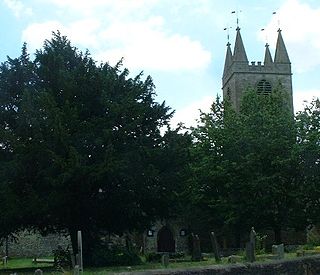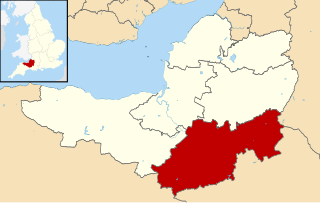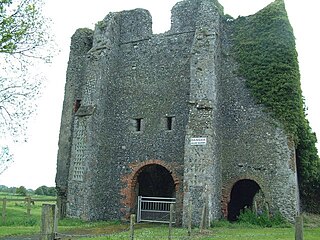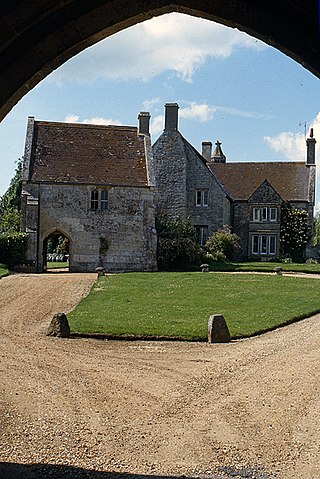
Deerhurst is a village and civil parish in Gloucestershire, England, about 2 miles (3 km) southwest of Tewkesbury. The village is on the east bank of the River Severn. The parish includes the village of Apperley and the hamlet of Deerhurst Walton. The 2011 Census recorded the parish's population as 906, the majority of whom live in Apperley.

Woodspring Priory is a former Augustinian priory. It is near the scenic limestone promontory of Sand Point and Middle Hope, owned by the National Trust, beside the Severn Estuary about 3 miles (5 km) north-east of Weston-super-Mare, within the English unitary authority of North Somerset. Many of the buildings are Grade I listed, and the whole site is scheduled as an ancient monument.

Baddiley is a scattered settlement and civil parish in the unitary authority of Cheshire East and the ceremonial county of Cheshire, England. The civil parish also includes the north-western part of the village of Ravensmoor, as well as the small settlements of Baddiley Hulse, Batterley Hill, and parts of Gradeley Green and Swanley. According to the 2001 Census the parish had a total population of 226, increasing at the 2011 Census to 249.

Marksbury is a small village and civil parish on the eastern edge of the affluent Chew Valley in Somerset, about 4 miles (6.4 km) from Keynsham and 7 miles (11.3 km) from Bath on the A39 where it meets the A368. The parish, which includes the villages of Hunstrete and Stanton Prior, has a population of 397.

Meare is a village and civil parish in Somerset, England, 3 miles (4.8 km) north-west of Glastonbury on the Somerset Levels. The parish includes the village of Westhay.
Mendip is a local government district in the English county of Somerset. The Mendip district covers a largely rural area of 285 square miles (738 km2) ranging from the Mendip Hills through on to the Somerset Levels. It has a population of approximately 11,000. The administrative centre of the district is Shepton Mallet.

South Somerset is a local government district in the English county of Somerset. The South Somerset district occupies an area of 370 square miles (958 km2), stretching from its borders with Devon and Dorset to the edge of the Somerset Levels. The district has a population of about 158,000, and has Yeovil as its administrative centre.

The Manor Farmhouse in Meare, Somerset, England, was built in the 14th century as the summer residence of the Abbots from Glastonbury Abbey and is now a farmhouse. Along with its outbuildings the farmhouse has been designated as a Grade I listed building.

Montacute Priory was a Cluniac priory of the Benedictine order in Montacute, Somerset, England.

Monkton Deverill is a village and former civil parish, now in the parish of Kingston Deverill, in Wiltshire, England, about five miles south of Warminster and four miles north-east of Mere. The area has been part of Kingston Deverill parish since 1934. It lies on the River Wylye and forms part of a group of villages known as the Upper Deverills. In 1931 the parish had a population of 108.
Ickleton Priory was a Benedictine priory of nuns at Ickleton, Cambridgeshire, England. It was established in the middle of the 12th century and suppressed in the Dissolution of the Monasteries in 1536.

St. Radegund's Abbey at Bradsole was a medieval monastic house in the parish of Hougham Without near Dover in southeast England. It was dedicated to Radegund, the sixth-century Merovingian princess, who, once married to the unsavory King Chlothar I, turned to a life of asceticism and charitable works. The remains of the abbey buildings have since have been incorporated into a farm.
Eye Priory was a Benedictine Priory dedicated to St Peter in the town of Eye in the English county of Suffolk. It was founded by Robert Malet c. 1080 and originally an Alien Priory dependent on Bernay Abbey in Normandy. It became independent in 1385 by charter of Richard II when it could support only 3-4 monks. It was finally dissolved in 1537 as part of the Dissolution of the Monasteries, with the lands being given to Charles Brandon, 1st Duke of Suffolk.

A total of 21 buildings and other structures in the English civil parish of Dodcott cum Wilkesley have been officially designated as listed buildings for their "special architectural and historic interest". Dodcott cum Wilkesley is in the Cheshire East division of the ceremonial county of Cheshire, situated on the Cheshire Plain at the border with Shropshire. The civil parish is predominantly rural, with many scattered minor settlements, the largest of which is the small village of Burleydam. One of the listed buildings is classified by English Heritage as being in grade I, meaning "of exceptional interest, sometimes considered to be internationally important" ; two are in grade II* and the remainder in grade II.

Mendip is a local government district in the English county of Somerset. The Mendip district covers a largely rural area of 285 square miles (738 km2) ranging from the Mendip Hills through on to the Somerset Levels. It had a population of approximately 110,000 in 2014. The administrative centre of the district is Shepton Mallet.

West Knoyle is a small village and civil parish in southwest Wiltshire, England, close to the southern edge of Salisbury Plain. The village is about 2.5 miles (4 km) east of Mere and 8 miles (13 km) south of Warminster. The A303 trunk road passes about 0.75 miles (1,210 m) north of the village.
Sawley is a civil parish in Ribble Valley, Lancashire, England. It contains twelve listed buildings that are recorded in the National Heritage List for England. Of these, one is listed at Grade I, the highest of the three grades, and the others are at Grade II, the lowest grade. The parish contains the village of Sawley and surrounding countryside. The most important building is Sawley Abbey, now in ruins; it is listed and is also a scheduled monument. Most of the other listed buildings are houses and associated structures, and farmhouses and farm buildings. In addition there are two bridges, a public house, and a milestone that are listed.
Whalley is a civil parish in Ribble Valley, Lancashire, England. It contains 29 listed buildings that are recorded in the National Heritage List for England. Of these, three are listed at Grade I, the highest of the three grades, one is at Grade II*, the middle grade, and the others are at Grade II, the lowest grade. The parish contains the small town of Whalley and surrounding countryside. The town has a long history and this is reflected in the oldest listed buildings, the parish church and the abbey. Most of the other listed buildings consist of houses and shops in the town. In addition there are two public houses, a sundial in the churchyard, a former school, a former corn mill, a war memorial and, outside the town, farmhouses and farm buildings, and a railway viaduct.

Lee Abbey, founded in 1946, is an ecumenical Christian community between Woody Bay and Lynmouth in Devon, England. It is a Grade II listed building.

Place Farm is a complex of medieval buildings in the village of Tisbury, Wiltshire, England. They originally formed a grange of Shaftesbury Abbey. The farmhouse, the inner and outer gatehouses and the barn, reputedly the largest in England, are all Grade I listed buildings.
















